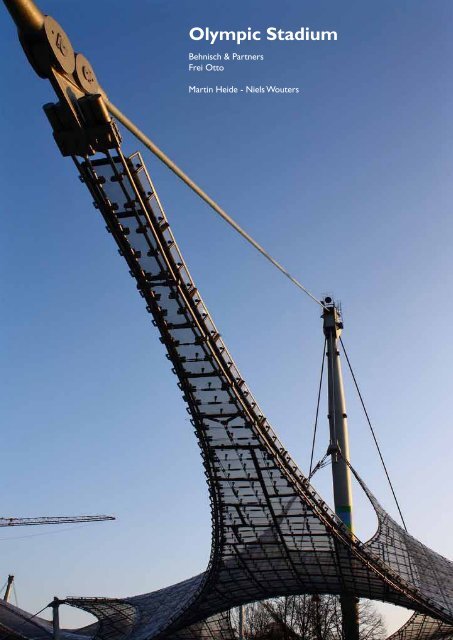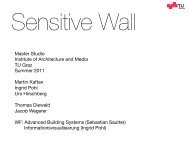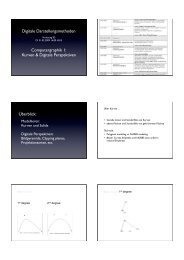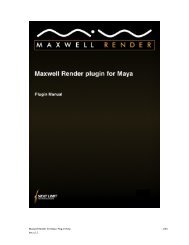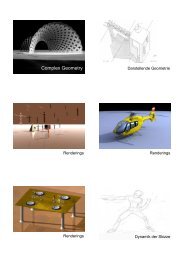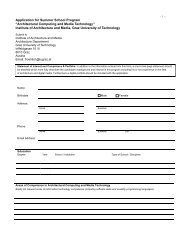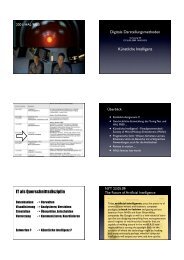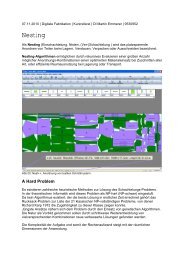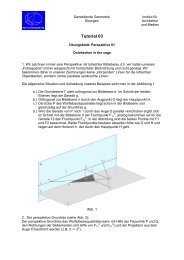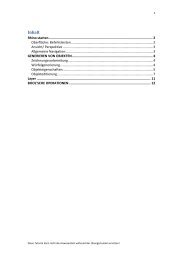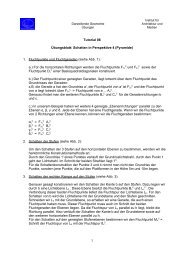Olympic Stadium - iam
Olympic Stadium - iam
Olympic Stadium - iam
Create successful ePaper yourself
Turn your PDF publications into a flip-book with our unique Google optimized e-Paper software.
<strong>Olympic</strong> <strong>Stadium</strong><br />
Behnisch & Partners<br />
Frei Otto<br />
Martin Heide - Niels Wouters
Introduction<br />
Experimental pavilion<br />
World’s Fairs, <strong>Olympic</strong> Games and Grand<br />
Expositions are acknowledged as proving grounds<br />
for experimental architecture. The centerpiece<br />
buildings at these venues are meant to impress<br />
their international spectators with technical and<br />
aesthetical flair. In a way they act as ambassadors<br />
of the host country’s progressive industry. The<br />
applicance of both daring materials and daring<br />
techniques are therefore obligatory.<br />
The Munich stadium complex for the 1972 Summer<br />
<strong>Olympic</strong>s is a perfect example of how site and<br />
structure can blend together. Undulating roofs and<br />
dramatically sculpted earthscapes unify the setting.<br />
Both inside the halls and out among the park setting<br />
visitors are provided with a sophisticated series of<br />
experiences.<br />
Functional requirements<br />
The original requirements, as imposed by the<br />
<strong>Olympic</strong> Committee, were very clear at the time.<br />
No less than 80,000 seats should be provided in<br />
the main stadium, and a smaller enclosed sports hall<br />
and swimming hall should also be provided. Other<br />
facilities should include a warm-up arena and an<br />
enclosed workout facility.<br />
The adjacent <strong>Olympic</strong> Village should provide<br />
housing for 3,000 people and the necessary support<br />
functions. These facilities were to be of permanent<br />
quality and convertible to public use and parkland<br />
after the three-week <strong>Olympic</strong> games. Thematically,<br />
the competition used the motto “<strong>Olympic</strong>s in the<br />
Green”.<br />
Site<br />
When the International <strong>Olympic</strong> Committee<br />
awarded the 1972 <strong>Olympic</strong> Games to Munich in<br />
1966, the city had no large sports arenas. Previous<br />
planning however had already selected he best site<br />
for the new facility, an empty tract of land about<br />
three miles north of central Munich.<br />
The site was originally the setting of a 1930’s airfield,<br />
a former training ground for the Bavarian Royal<br />
Army and the site of Munich’s first civil airport.<br />
During the cleanup after the second World War, the<br />
ground had been used as a dump yard for ruined<br />
buildings’ rubble. Moreover a 300m tall broadcast<br />
tower, which is still present today, is a major<br />
landmark of the site.<br />
2
Construction 3<br />
Conceptual phase<br />
Through its planning, development and current<br />
perception, Olympiapark manages to set several<br />
keynotes. First of all the tensile structure and<br />
translucent skin were revolutionary at the time<br />
and remain both visually and technically impressive<br />
today. The formal language as it was interpreted<br />
by architects Behnisch and partners is a strong<br />
statement about Germany and its industrial<br />
capabilities. As the whole park has been constructed<br />
on an abandoned airfield covered with remnants of<br />
the war, the city has reclaimed an important green<br />
area. Contrary to what happens to many other<br />
venue halls, the whole complex has been put to<br />
permanent use as soon as the primary purpose had<br />
been served: it has now become a sports stadium,<br />
and a frequently visited park with a main focus on<br />
sports.<br />
Critical technical issues<br />
A stadium of <strong>Olympic</strong> importance should respond<br />
with corresponding attention to the primary<br />
functions it hosts. Orientation to sun and wind<br />
have to ensure equitable outdoor conditions for all<br />
competitors. Moreover, accomodation and transport<br />
should be provided for many thousands of visitors.<br />
Special circumstances heavily influenced design<br />
thinking. Two questions dominated this project. The<br />
first issue that arose was speed of construction.<br />
Deadlines were absolute and the time line for<br />
developing the huge site (including the <strong>Olympic</strong><br />
Village) was short. Speed of construction and the<br />
risk of delays would have to be considered. Second,<br />
what would happen to the complex after the<br />
<strong>Olympic</strong>s? Given the costs associated with such<br />
a grand occasion and the extensive facilities that<br />
would remain, their future use had to be designed<br />
for. A temporary structure would be insufficient, and<br />
a monumental one would be a perpetual burden.<br />
A third requirement emerged during a later phase,<br />
and took requirements of broadcast color television<br />
into account. Television would have its say; since<br />
the 1964 Summer <strong>Olympic</strong>s in Tokyo, live color<br />
television coverage had become the standard and<br />
had extensively penetrated the market. In essence<br />
the television companies had requirements towards<br />
lighting, shadow reduction, and acoustics.
Climate<br />
Despite Munich’s temperate weather, the design of a<br />
cable net roof structure had to address two critical<br />
factors: wind and snow. Freezing rain, snow or hail<br />
falls an average of 75 days per year in Munich, and<br />
wind gushes can exceed 120 km/h during stormy<br />
weather.<br />
Heavy snow and ice accumulations on the unheated<br />
roof could impose dangerous structural loads.<br />
Basically this issue could be resolved by placing large<br />
fans under the canopy to melt snow off the top.<br />
This technique had a proven record in the Otto’s<br />
German Pavilion at the 1967 World Fair in Montreal.<br />
Given the climate conditions in Munich and<br />
especially the prevailing wind direction, both the<br />
tensile roof and the main seating area are oriented<br />
at the western edge. Approximately 65% of the<br />
stadium’s visitors are thus given shelter from the<br />
natural elements.<br />
The roof and the higher seating area on the<br />
western side also guarantee the eastern seats to be<br />
somewhat more protected from wind. Nevertheless,<br />
in current <strong>Olympic</strong> stadiums, an uncovered seating<br />
area would not be allowed anymore.<br />
4
Roof<br />
Without doubt the most remarkable feature of the<br />
stadium and the adjacent buildings is the tensile roof<br />
structure. It has become not only a landmark for the<br />
city of Munich, but has been a precedent for many<br />
more innovations in this field of study in later years.<br />
It is especially the size and the grandeur of the roof<br />
which has inspired many architects and designers.<br />
The roof grid over the main stadium is formed<br />
by nine saddle-shaped nets of 25mm steel cables<br />
spaced in a 762mm square grid. The saddle spans up<br />
to 65m and reaches a maximum height of 58m. The<br />
nets are supported over the seating areas by eight<br />
tapering masts behind the stadium, ranging from 50<br />
to 70m high. Smaller bow-shaped nets connect the<br />
larger membranes and wrap around the supporting<br />
masts.<br />
The cable nets are doubly curved. The resulting<br />
double-curved saddle shape prevents the canopies<br />
from easily fluttering in the wind. The total length<br />
of steel cable in the complex exceeds 408km and<br />
tension loads in the cable net are as much as 5000<br />
tons. Originally the foundation design was intended<br />
to consist of prestressed anchors. Local code<br />
officials however insisted on more conservative<br />
piers to provide stability. In some cases these piers<br />
are as much as 18m deep and 6m wide. These<br />
enormous foundations were required to resist the<br />
tremendous tensile stresses in the cable network<br />
and the live loads imposed by winds across and<br />
under the open structures.<br />
Envelope<br />
Originally one intended to hang a canvas fabric<br />
below the cable net, just as Otto did in Montreal.<br />
As television companies became involved however,<br />
the issue of excessive contrast for broadcast,<br />
photography suggested modification. In the end,<br />
bronze-tinted acrylic plastic panels measuring<br />
2,9 by 2,9m were installed above the cable wires.<br />
Connections between the panels had to allow for<br />
thermal expansion and structural movement of up<br />
to 1m deflection under heavy wind loads. The acrylic<br />
panels were attached to the supporting net at the<br />
intersection points of the cables. However, because<br />
of the irregularity of the net, the panels sometimes<br />
overlapped the cable grid at varying angles.<br />
Apart from offering enough color contrast for<br />
improved photography, the bronze tinting also<br />
helped reduce heat gains and glare without casting<br />
shadows as a canvas canopy would have.<br />
5
Mechanical<br />
Buried under the stadium seating in the sports hall<br />
and the swimming pool, 49 air-handling units are<br />
served with hot and cold water from a central plant<br />
located on the other half of the site. Additionally a<br />
19km network of hot water piping was buried 25cm<br />
below the grass surface of the stadium playing field<br />
to allow year round use.<br />
Experimenting<br />
Since this project has been executed before our<br />
current digital age, all of the calculations had been<br />
done by hand. Most of the engineering was also the<br />
result of practical experiments, mostly conducted by<br />
Frei Otto himself, and based on models in varying<br />
scales.<br />
Otto started with models of the roof at a 1:125<br />
scale. He measured the mechanical forces in the<br />
individual wires of the net with gauges he had<br />
developed himself. Several fixed cameras recorded<br />
both the loaded and unloaded shape of the model<br />
for comparative measurements.<br />
As soon as these experiments offered the<br />
necessary insight in how these constructions<br />
worked and reacted, larger models were built and<br />
hand calculations were performed for verification.<br />
Therefore, architects and engineers used drawings<br />
on a 1:10 scale, resulting in 3.800 sqm of drawings.<br />
6
References<br />
Integrated Buildings - The Systems Basis of Architecture, Leonard R. Bachman, John Wiley & Sons, 2003<br />
Das Stahlbau-Dach, Preussag AG Abt. Öffentlichkeitsarbeit, Willy F. P. Fehling GmbH, 1975<br />
Günter Behnisch, Günter Behnisch, Birkhäuser, 2003<br />
10


